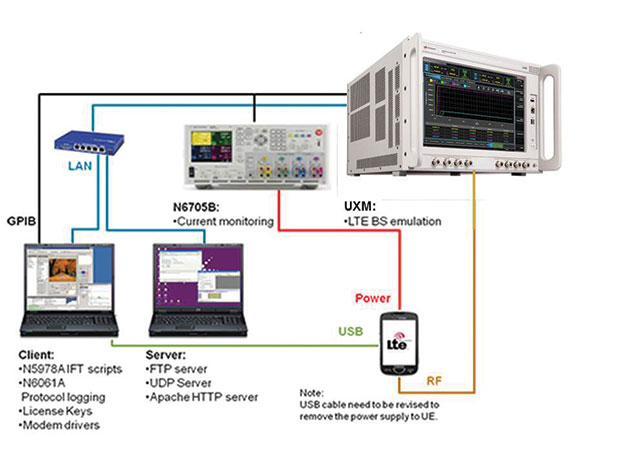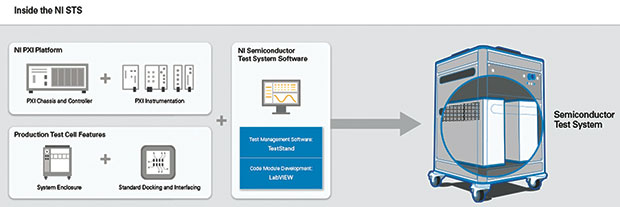
Keysight Technologies hardware as well as N5978AIFT scripts and N6061A protocol logging and analysis software for LTE-A work together to analyze a variety of IoT testing issues in wireless applications. Image courtesy of Keysight Technologies.
Latest News
March 1, 2015
The software, sensing and connectivity requirements of Internet of Things (IoT) devices bring new complications to testing. Design engineers have several options to consider. IoT testing approaches include technology-specific testing, traditional automated test equipment (ATE) that uses different hardware to conduct specific tests, software-centric approaches and vendor-specific testing resources. Testing services provide yet another option.
Testing is performed to verify that something works as expected and it is within specifications to debug software. It also confirms the ability to meet industry standards, such as interoperability and others. In addition to ATE, development platforms and testbeds enable these activities.
Vendor-Specific Testing
Formed in 2014 by AT&T, Cisco, GE, Intel and IBM, the Industrial Internet Consortium (IIC) has a goal to utilize existing use cases and create new industry use cases and testbeds for real-world applications. As the IIC explains on its website, “A testbed is a controlled experimentation platform, conforming to an IIC reference architecture, where solutions can be deployed and tested in an environment that resembles real-world conditions.”
In fact, testing is the key to IoT growth.
“Innovation is the ultimate goal of IoT. Technology, interoperability, security, data privacy—those are obviously important but they are just the enablers. Testbeds help expedite and validate those aspects and more,” says Lynne Canavan, program director for the IIC. “The real ROI (return on investment) will come from innovative new products and services plus huge efficiency gains that represent the third revolution in modern industry: the Industrial Internet.”
As a member of the IIC, Fujitsu has made an IoT platform in collaboration with IQP Japan Corporation, a developer of applications and platforms. With the platform, Fujitsu provides up to six months free use of application development and execution via the Fujitsu Cloud.
“To realize our vision of ‘Human-Centric IoT’, Fujitsu has launched an IoT platform to enable rapid development and testing of impactful and innovative new products and solutions,” says Jane Yin, vice president, Marketing & Open Innovation Group, Fujitsu Laboratories of America Inc.
A Software-Centric Approach
National Instruments’ (NI) approach to IoT testing consists of a hardware platform and software for testing in both the design and manufacturing phases. The Semiconductor Test System, or STS, provides a single technology-specific package for easy integration into a semiconductor production environment. Commonality was a major goal of the test system design.
 Based on the PXI platform, NI’s Test System Software provides a flexible IoT test solution that can change with the changing requirements of users that are addressing the IoT. Image courtesy of National Instruments.
Based on the PXI platform, NI’s Test System Software provides a flexible IoT test solution that can change with the changing requirements of users that are addressing the IoT. Image courtesy of National Instruments.“As much as you can get commonality around the physical way of making the measurement, as well as the software algorithms that are processing the bits that you are bringing in from the physical world, the better,” says Luke Schreier, director of Automated Test product marketing at NI. “Because then you spend less time debugging the test system or simulation system and more time focusing on the thing you are building,”
Integrated Device Technology (IDT), a semiconductor manufacturer and a lead user of the STS, discussed its success with it at NIWeek 2014. Reducing the cost of test was a major goal and common test platforms were pursued as a solution.
“It gives us the flexibility to address the need of various business units,” said Rebecca Jimenez, vice president for Worldwide Test Operations at IDT. “By keeping this in mind during the initial hardware stages, we have been able to stay with a standard configuration, which is key for manufacturing. We already have three systems running in production.”
Technology-Specific Testing
Achieving seamless connectivity and transitions such as 3G to 4G and performing 4G to 5G investigations and studies also require the use of platforms and testbeds. Qualcomm has created an Internet of Everything (IoE) Development Platform so users have hardware and software for designing and building machine-to-machine (M2M) devices with built-in cellular connectivity and an IoE Wi-Fi Development Platform.
Mike Stauffer, senior director of business development for IoE business at Qualcomm says the experts for the enabling IoT connectivity technologies typically provide tested and compliant subassemblies for the lowest levels.
In the software stack, other tests are required, particularly those that ensure interoperability at the application level.
“It’s great that you can hook up two devices that can actually send some packets back and forth, but you need to be able to interpret the meaning of those packets to do a lot of useful things for the IoE,” says Stauffer.
Automated Test Equipment
No matter what type of testbed or platform is used, additional analytical equipment may be required. Keysight Technologies, a spinoff of Agilent Technologies, manufactures test equipment for a variety of measurement and testing situations.
One of the newest hardware tools for IoT testing is the E7515A UXM Wireless Test Set used for LTE-Advanced design validation and more. It is part of a test environment that can be configured with other Keysight products.
“The N6705B and N5978AIFT scripts work with the UXM to address complexity and other testing issues associated with the IoT,” says Jan Whitacre, manager of the Wireless Technology Program at Keysight Technologies
 Keysight Technologies hardware as well as N5978AIFT scripts and N6061A protocol logging and analysis software for LTE-A work together to analyze a variety of IoT testing issues in wireless applications. Image courtesy of Keysight Technologies.
Keysight Technologies hardware as well as N5978AIFT scripts and N6061A protocol logging and analysis software for LTE-A work together to analyze a variety of IoT testing issues in wireless applications. Image courtesy of Keysight Technologies.Testing: At Your Service
Testing services help their clients get to market quicker and with greater confidence of interoperability. Testing services offer companies an alternative to acquiring and maintaining their own in-house assets. In the rapidly changing area of the IoT, it can provide a new option to users who are venturing into new territory.
One provider, CSC, has an IoT Testing Lab in Utah that works on IoT testing techniques, certification and creation of testing models. The facility focuses on interoperability of embedded systems with wired and wireless connectivity to the Internet.
“We are already implementing and developing IoT Testing using a TaaS (testing-as-a-service) model,” says Manish Tomar, vice president and general manager, Applications Managed Services, CSC. “This is in line with CSC’s vision of next-generation applications and service-enabled enterprise.”
The IoT is all about connectivity. “When we think of the Industrial Internet, we are looking at transformational breakthroughs. We are, today, starting to make things happen in ways that couldn’t happen before,” says IIC’s Canavan.
To do this, the way companies think about testing will be a key part of how things are done differently.
More Info
Subscribe to our FREE magazine, FREE email newsletters or both!
Latest News
About the Author
Randy FrankRandy Frank is a freelance technology writer based in Arizona. Contact him via [email protected].
Follow DE





